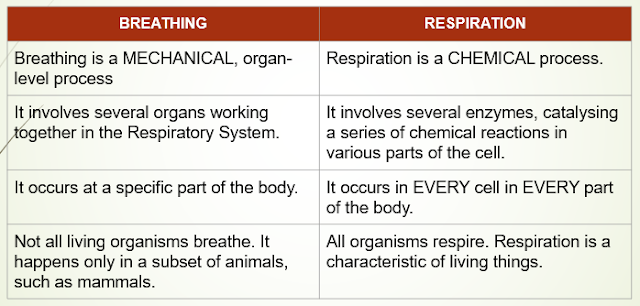RESPIRATION, GASEOUS EXCHANGE, AND BREATHING [CSEC BIOLOGY & HSB]
SYLLABUS REFERENCE
CSEC HSB
- [B2.1] explain the importance of breathing in humans;
- [B2.2] relate the structures of the respiratory tract to their functions;
- [B2.3] describe the breathing mechanism;
- [B2.6] distinguish between gaseous exchange and breathing;
- [B2.7] identify characteristics common to gaseous exchange surfaces;
- [B2.8] differentiate between aerobic and anaerobic respiration;
CSEC BIOLOGY
- [B3.1] describe the process of aerobic respiration;
- [B3.2] distinguish between aerobic and anaerobic respiration;
- [B3.3] describe the mechanism of breathing in humans and gaseous exchange in flowering plants;
- [B3.4] identify characteristics common to gaseous exchange surfaces;
BREATHING VS RESPIRATION
RESPIRATION EQUATIONS
GASEOUS EXCHANGE SURFACES (GES)
Gaseous Exchange Surfaces are surfaces across which respiratory gases are exchanged. At this point, substrate gases enter the organism and waste gases leave.
In humans, the GES is the alveolus (alveoli, plural), aka air sac.
BREATHING VS GASEOUS EXCHANGE
CHARACTERISTICS OF
GASEOUS EXCHANGE SURFACES
These surfaces are adapted to maximize the rate of diffusion in several ways, as follows. These characteristics are found in gaseous exchange surfaces across the living world, but expressed in different ways.
1 - The surface is thin, giving the shortest possible distance for the gases to travel.
2 - The surface is moist, so that the gases can go into solution.
3 - The surface are is maximized via folding and/or branching.
4 - The surface is intimately connected to the body's transport medium, often via a connection to an extensive network of blood vessels.
5 - The surface is kept in contact with the atmosphere.
THE RESPIRATORY SYSTEM
THE BREATHING PROCESS
BREATHING IN (INSPIRATION)
- The diaphragm CONTRACTS and flattens downward.
- The intercostal muscles between the ribs CONTRACT and moves the ribs up and outwards.
- Volume in the thorax INCREASES, air pressure DECREASES.
- Since air pressure in the thorax is lower than the surrounding atmosphere. Air therefore moves down its pressure gradient from the atmosphere to the lungs via the trachea.
BREATHING OUT (EXPIRATION)
- The diaphragm RELAXES and moves back upwards into an arc shape.
- The intercostal muscles between the ribs RELAX and moves the ribs back down and inwards.
- Volume in the thorax DECREASES, air pressure INCREASES.
- Since air pressure in the thorax is higher than the surrounding atmosphere. Air therefore moved down its pressure gradient from the lungs to the atmosphere via the trachea.












